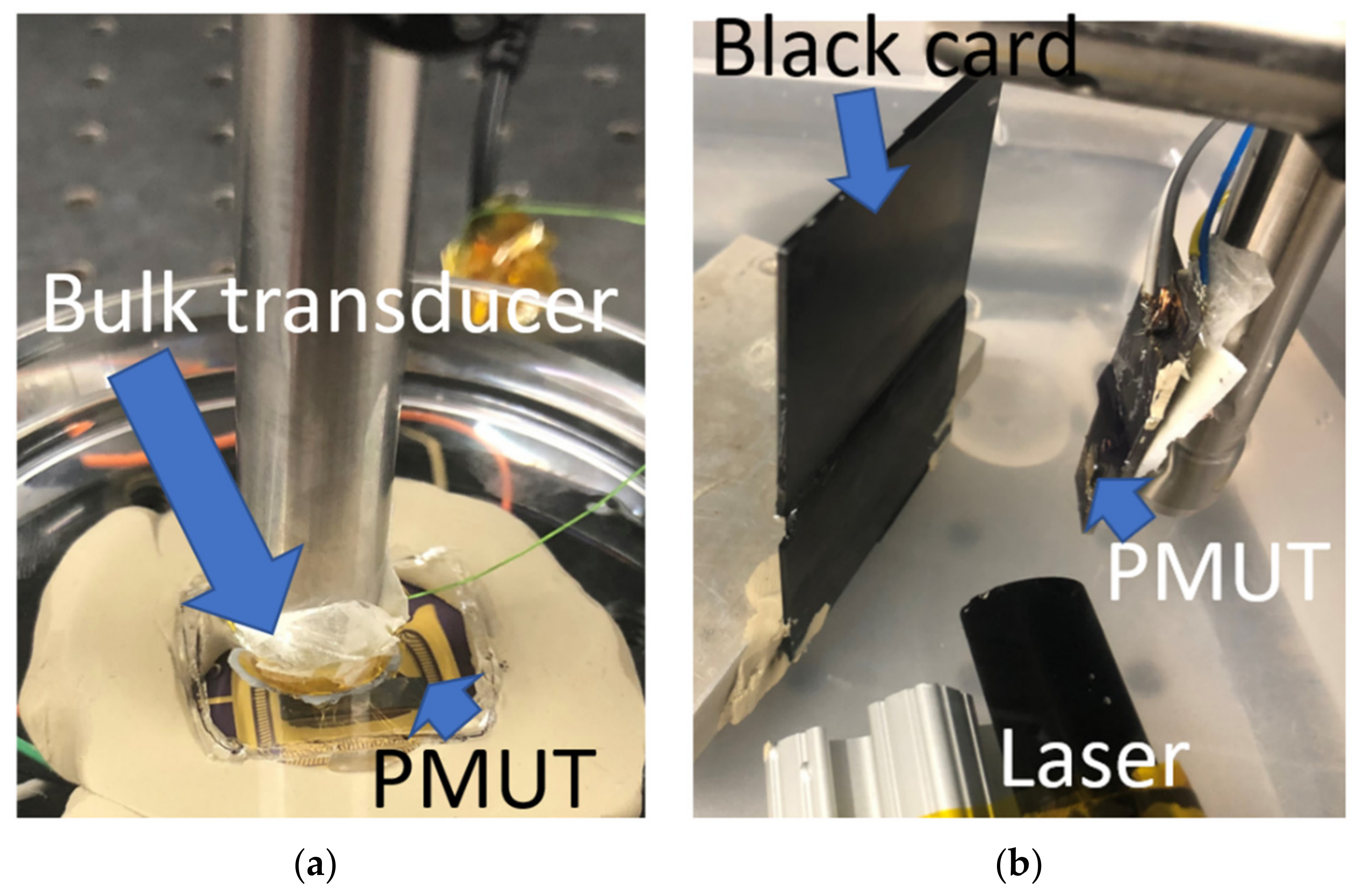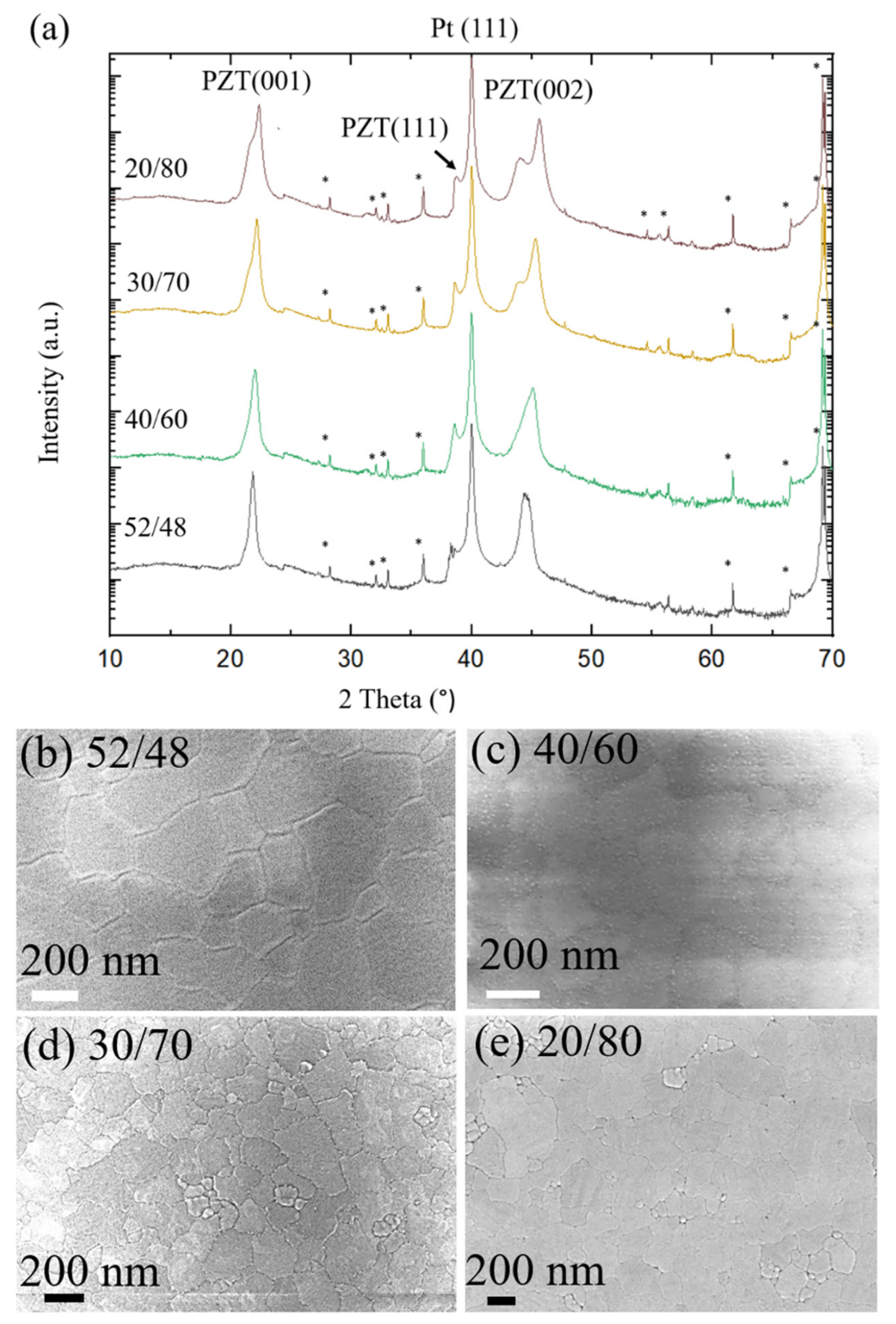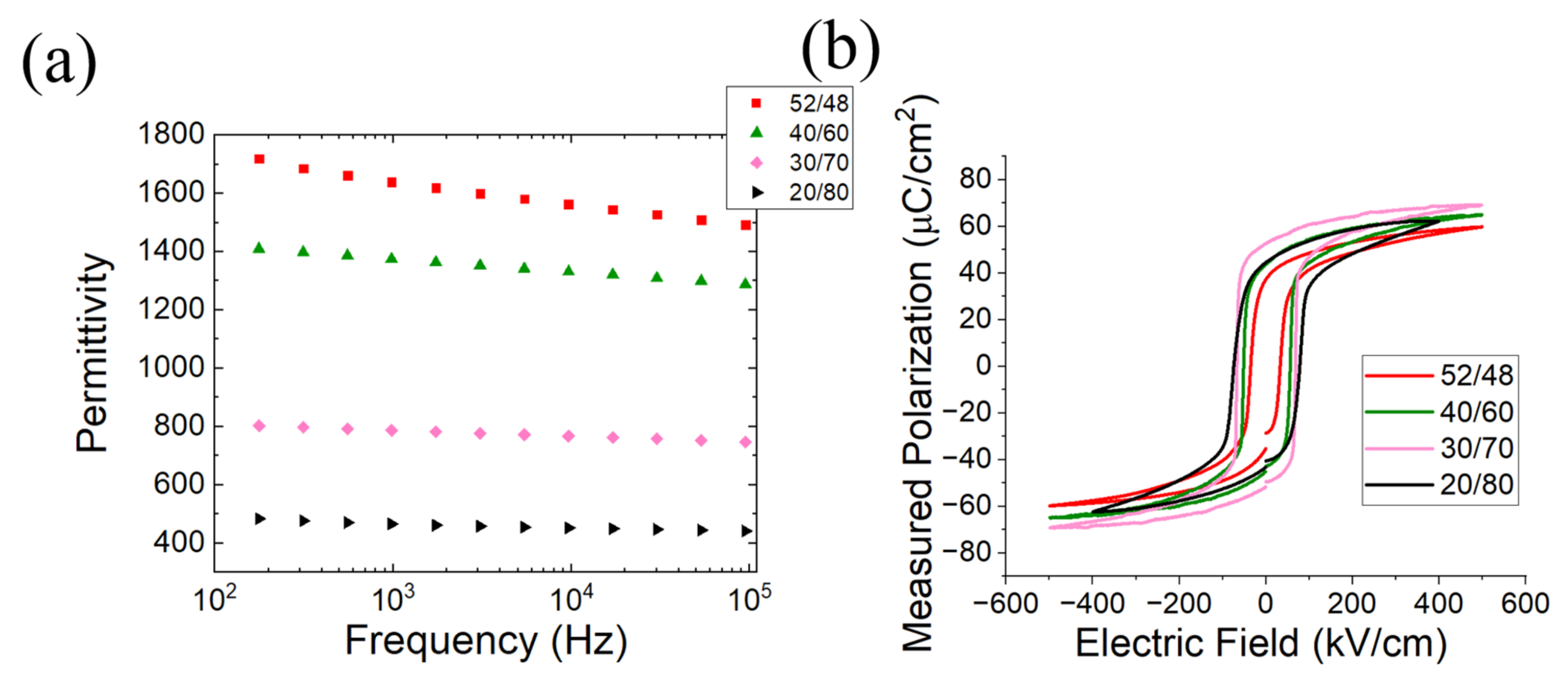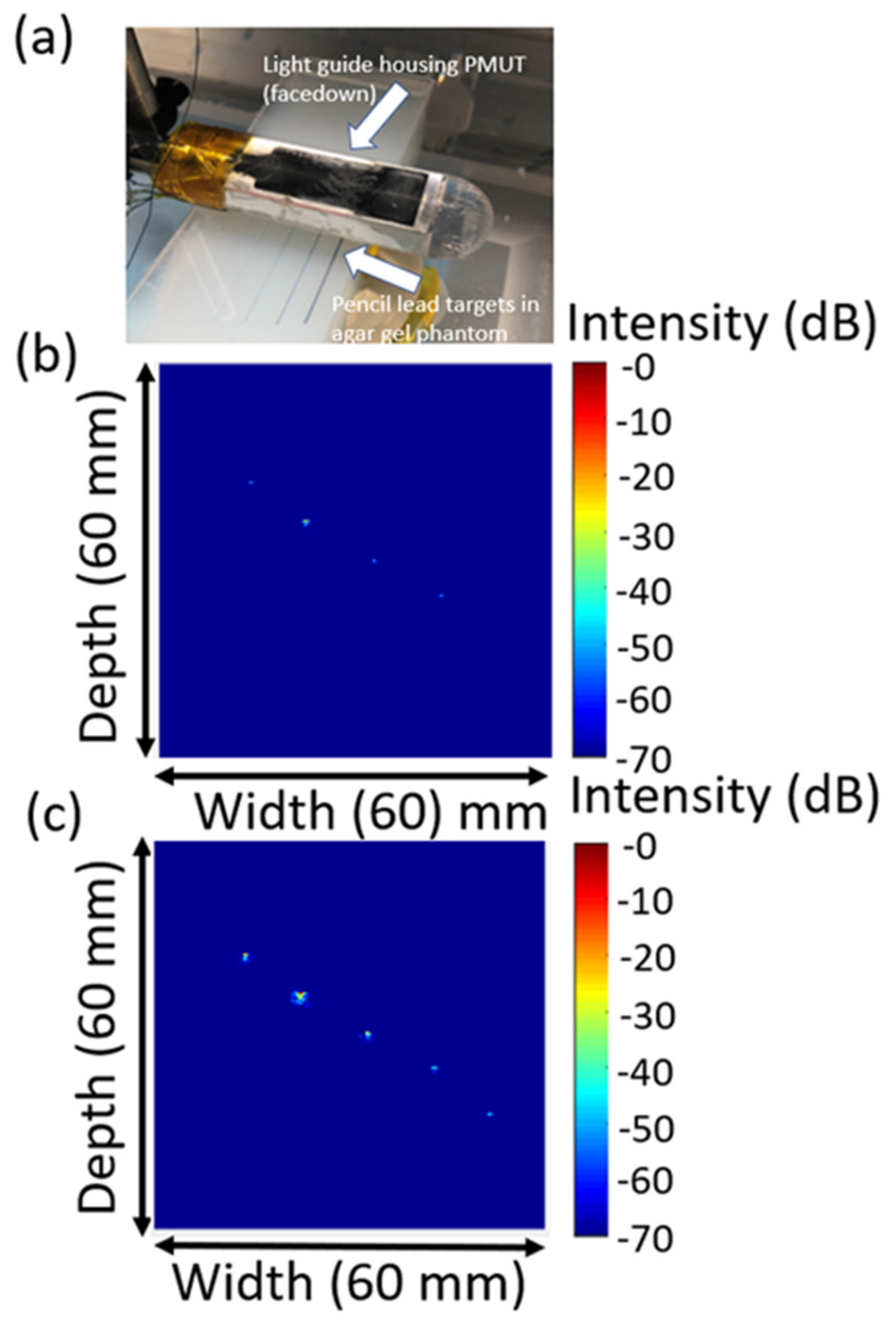Improving PMUT Receive Sensitivity via DC Bias and Piezoelectric Composition
Abstract
:1. Introduction
2. Materials and Methods
3. Results
3.1. Structural Measurements
3.2. Electrical Measurements
3.3. Underwater Acoustic Measurements
4. Conclusions
Author Contributions
Funding
Data Availability Statement
Conflicts of Interest
References
- Mattiat, O.E. Ultrasonic Transducer Materials; Plenum Press: New York, NY, USA, 1971. [Google Scholar]
- Park, K.K.; Oralkan, O.; Khuri-Yakub, B.T. A Comparison Between Conventional and Collapse-Mode Capacitive Micromachined Ultrasonic Transducers in 10-MHz 1-D Arrays. IEEE Trans. Ultrason. Ferroelectr. Freq. Control. 2013, 60, 1245–1255. [Google Scholar] [CrossRef] [PubMed]
- Hajati, A.; Latev, D.; Gardner, D.; Hajati, A.; Imai, D.; Torrey, M.; Schoeppler, M. Three-Dimensional Micro Electromechanical System Piezoelectric Ultrasound Transducer. Appl. Phys. Lett. 2012, 101, 253101. [Google Scholar] [CrossRef] [Green Version]
- Kim, K.; Choi, H. High-Efficiency High-Voltage Class F Amplifier for High-Frequency Wireless Ultrasound Systems. PLoS ONE 2021, 16, e0249034. [Google Scholar] [CrossRef]
- Wang, Q.; Lu, Y.; Mishin, S.; Oshmyansky, Y.; Horsley, D.A. Design, Fabrication, and Characterization of Scandium Aluminum Nitride-Based Piezoelectric Micromachined Ultrasonic Transducers. J. Microelectromech. Syst. 2017, 26, 1132–1139. [Google Scholar] [CrossRef]
- Kusano, Y.; Wang, Q.; Luo, G.L.; Lu, Y.; Rudy, R.Q.; Polcawich, R.G.; Horsley, D.A. Effects of DC Bias Tuning on Air-Coupled PZT Piezoelectric Micromachined Ultrasonic Transducers. J. Microelectromech. Syst. 2018, 27, 296–304. [Google Scholar] [CrossRef]
- Bassiri-Gharb, N.; Fujii, I.; Hong, E.; Trolier-McKinstry, S.; Taylor, D.; Damjanovic, D. Domain Wall Contributions to the Properties of Piezoelectric Thin Films. J. Electroceram. 2007, 19, 49–67. [Google Scholar] [CrossRef]
- Muralt, P.; Ledermann, N.; Baborowski, J.; Barzegar, A.; Gentil, S.; Belgacem, B.; Petitgrand, S.; Bosseboeuf, A.; Setter, N. Piezoelectric Micromachined Ultrasonic Transducers Based on PZT Thin Films. IEEE Trans. Ultrason. Ferroelectr. Freq. Control. 2005, 52, 2276–2288. [Google Scholar] [CrossRef] [PubMed]
- Masuda, Y.; Baba, A.D.C. Bias and Frequency Dependence of the Dielectric Constant PZT Family Ferroelectric Ceramics. Jpn. J. Appl. Phys. 1985, 24, 113–116. [Google Scholar] [CrossRef] [Green Version]
- Cheng, C.Y.; Dangi, A.; Ren, L.; Tiwari, S.; Benoit, R.R.; Qiu, Y.; Lay, H.S.; Agrawal, S.; Pratap, R.; Kothapalli, S.R.; et al. Thin Film PZT-Based PMUT Arrays for Deterministic Particle Manipulation. IEEE Trans. Ultrason. Ferroelectr. Freq. Control. 2019, 66, 1606–1615. [Google Scholar] [CrossRef] [PubMed] [Green Version]
- Dausch, D.E.; Gilchrist, K.H.; Carlson, J.R.; Castelucci, J.B.; Chou, D.R.; von Ramm, O.T. Improved Pulse-Echo Imaging Performance for Flexure-Mode pMUT Arrays. In Proceedings of the 2010 IEEE International Ultrasonics Symposium, San Diego, CA, USA, 11–14 October 2010; pp. 451–454. [Google Scholar]
- Hiboux, S.; Muralt, P.; Maeder, T. Domain and Lattice Contributions to Dielectric and Piezoelectric Properties of Pb(Zrx,Ti1-x)O3 Thin Films as a Function of Composition. J. Mater. Res. 1999, 14, 4308–4318. [Google Scholar] [CrossRef] [Green Version]
- Gerber, P.; Bottger, U.; Waser, R. Composition Influences on the Electrical and Electromechanical Properties of Lead Zirconate Titanate Thin Films. J. Appl. Phys. 2006, 100, 124105. [Google Scholar] [CrossRef] [Green Version]
- Fox, A.; Drawl, B.; Fox, G.R.; Gibbons, B.J.; Trolier-McKinstry, S. Control of Crystallographic Texture and Surface Morphology of Pt/TiO2 Templates for Enhanced PZT Thin Film Texture. IEEE Trans. Ultrason. Ferroelectr. Freq. Control. 2015, 62, 56–61. [Google Scholar] [CrossRef] [PubMed]
- Borman, T.; Ko, S.; Mardilovich, P.; Trolier-McKinstry, S. Development of Crystallographic Texture in Chemical Solution Deposited Lead Zirconate Titanate Seed Layers. J. Am. Ceram. Soc. 2017, 100, 4476–4482. [Google Scholar] [CrossRef]
- Borman, T.; Zhu, W.; Wang, K.; Ko, S.; Mardilovich, P.; Trolier-McKinstry, S. Effect of Lead Content on the Performance of Niobium-doped {100} Textured Lead Zirconate Titanate Films. J. Am. Ceram. Soc. 2017, 100, 3558–3567. [Google Scholar] [CrossRef]
- Dangi, A.; Cheng, C.Y.; Agrawal, S.; Tiwari, S.; Datta, G.R.; Benoit, R.R.; Pratap, R.; Trolier-McKinstry, S.; Kothapalli, S.R. A Photoacoustic Imaging Device Using Piezoelectric Micromachined Ultrasound Transducers (PMUTs). IEEE Trans. Ultrason. Ferroelectr. Freq. Control. 2020, 67, 801–809. [Google Scholar] [CrossRef]
- Yi, G.; Wu, Z.; Sayer, M. Preparation of Pb(Zr, Ti)O3 Thin Films By Sol Gel Processing: Electrical, Optical, and Electro-Optic Properties. J. Appl. Phys. 1988, 64, 2717. [Google Scholar] [CrossRef]
- Assink, R.A.; Schwartz, R.W. Proton and Carbon-13 NMR Investigations of Lead Zirconate Titanate (Pb(Zr, Ti)O3) Thin-Film Precursor Solutions. Chem. Mater. 1993, 5, 511–517. [Google Scholar] [CrossRef]
- Olding, T.; Leclerc, B.; Sayer, M. Processing of Multilayer PZT Coatings for Device Purposes. Integr. Ferroelectr. 1999, 26, 225–241. [Google Scholar] [CrossRef]
- Schwartz, R.W. Chemical Solution Deposition of Perovskite Thin Films. Chem. Mater. 1997, 9, 2325–2340. [Google Scholar]
- Tuttle, B.A.; Schwartz, R.W. Solution Deposition of Ferroelectric Thin Films. MRS Bull. 1996, 21, 49–54. [Google Scholar] [CrossRef]
- Schwartz, R.; Boyle, T.; Lockwood, S.; Sinclair, M.B.; Dimos, D.; Buchheit, C.D. Sol-gel Processing of PZT Thin Films: A Review of The State-of-the-Art and Process Optimization Strategies. Integr. Ferroelectr. 1994, 7, 259–277. [Google Scholar] [CrossRef]
- Lockwood, S.J.; Schwartz, R.W.; Tuttle, B.A.; Thomas, E.V. Solution Chemistry Optimization of Sol-Gel Processed PZT Thin Films. MRS OPL 1993, 310, 275–280. [Google Scholar] [CrossRef] [Green Version]
- Shepard, J.F., Jr.; Moses, P.J.; Trolier-McKinstry, S. The Wafer Flexure Technique for the Determination of the Transverse Piezoelectric Coefficient (d31) of PZT Thin Films. Sens. Actuators A Phys. 1998, 71, 133–138. [Google Scholar] [CrossRef]
- Dangi, A.; Pratap, R. System Level Modeling and Design Maps of PMUTs With Residual Stresses. Sens. Actuators A Phys. 2017, 262, 18–28. [Google Scholar] [CrossRef]
- Jiang, X.; Lu, Y.; Tang, H.; Tsai, J.; Ng, E.; Daneman, M.; Boser, B.; Horsley, D.A. Monolithic Ultrasound Fingerprint Sensor. Nature 2017, 3, 17059. [Google Scholar] [CrossRef] [PubMed] [Green Version]
- Balasingam, J.A.; Swaminathan, S.; Emadi, A. A Low-Frequency Piezoelectric Micromachined Ultrasonic Transducer based on Multi-User MEMS Process with Enhanced Output Pressure. In Proceedings of the 2020 IEEE International Ultrasonics Symposium (IUS), Las Vegas, NV, USA, 7–11 September 2020; pp. 1–4. [Google Scholar]
- Lysne, P.C. Dielectric Breakdown of Shock-Loaded PZT 65/35. J. Appl. Phys. 1972, 44, 577–582. [Google Scholar] [CrossRef]
- Cheng, C. Piezoelectric Micromachined Ultrasound Transducers Using Lead Zirconate Titanate Films. Ph.D. Thesis, Department of Materials Science and Engineering, The Pennsylvania State University, University Park, PA, USA, 2021. [Google Scholar]
- Akkopru-Akgun, B.; Zhu, W.; Randall, C.A.; Lanagan, M.T.; Trolier-McKinstry, S. Polarity Dependent DC Resistance Degradation and Electrical Breakdown in Nb Doped PZT Films. APL Mat. 2019, 7, 120901. [Google Scholar] [CrossRef] [Green Version]
- Dahl-Hansen, R.P.; Tyholdt, F.; Gjessing, J.; Vogl, A.; Wittendorp, P.; Vedum, J.; Tybell, T. On the effect of Water-Induced Degradation of Thin-Film Piezoelectric Microelectromechanical Systems. J. Microelectromech. Syst. 2020, 30, 105–115. [Google Scholar] [CrossRef]









Publisher’s Note: MDPI stays neutral with regard to jurisdictional claims in published maps and institutional affiliations. |
© 2022 by the authors. Licensee MDPI, Basel, Switzerland. This article is an open access article distributed under the terms and conditions of the Creative Commons Attribution (CC BY) license (https://creativecommons.org/licenses/by/4.0/).
Share and Cite
Cheng, C.; Peters, T.; Dangi, A.; Agrawal, S.; Chen, H.; Kothapalli, S.-R.; Trolier-McKinstry, S. Improving PMUT Receive Sensitivity via DC Bias and Piezoelectric Composition. Sensors 2022, 22, 5614. https://doi.org/10.3390/s22155614
Cheng C, Peters T, Dangi A, Agrawal S, Chen H, Kothapalli S-R, Trolier-McKinstry S. Improving PMUT Receive Sensitivity via DC Bias and Piezoelectric Composition. Sensors. 2022; 22(15):5614. https://doi.org/10.3390/s22155614
Chicago/Turabian StyleCheng, Christopher, Travis Peters, Ajay Dangi, Sumit Agrawal, Haoyang Chen, Sri-Rajasekhar Kothapalli, and Susan Trolier-McKinstry. 2022. "Improving PMUT Receive Sensitivity via DC Bias and Piezoelectric Composition" Sensors 22, no. 15: 5614. https://doi.org/10.3390/s22155614
APA StyleCheng, C., Peters, T., Dangi, A., Agrawal, S., Chen, H., Kothapalli, S.-R., & Trolier-McKinstry, S. (2022). Improving PMUT Receive Sensitivity via DC Bias and Piezoelectric Composition. Sensors, 22(15), 5614. https://doi.org/10.3390/s22155614





